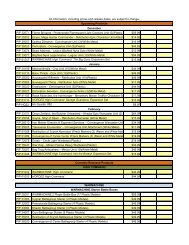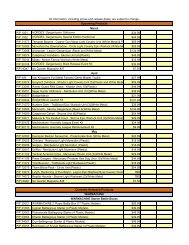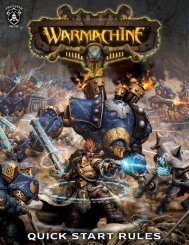Hordes MkII Quick Start Rules - Privateer Press
Hordes MkII Quick Start Rules - Privateer Press
Hordes MkII Quick Start Rules - Privateer Press
You also want an ePaper? Increase the reach of your titles
YUMPU automatically turns print PDFs into web optimized ePapers that Google loves.
model from charging, such as a penalty to its SPD, also prevent the model from making a slam<br />
power attack. A model must have both its normal movement and its action available in order<br />
to use its normal movement to make a slam power attack.<br />
During its activation, a model can attempt to slam any model that is in its line of sight at the<br />
beginning of its normal movement. A knocked down model cannot be slammed.<br />
Declare the slam attempt and its target, then turn the slamming model to directly face the<br />
slam target. The slamming model advances its full SPD plus 3˝ directly toward its target. The<br />
slamming model cannot voluntarily stop its movement unless its target is in its melee range,<br />
but it can end this movement at any point within 0.5˝ of its target. It must stop if it contacts<br />
another model. The slamming model cannot change its facing during or after this movement.<br />
A slamming model that ends its slam movement within 0.5˝ of its target has made a successful<br />
slam. If it advanced at least 3˝ it makes a melee attack roll against its target. A model that<br />
power attack slams a model with a larger base suffers –2 on its attack roll. If the attack hits,<br />
the target is slammed directly away from the attacker.<br />
If a slamming model makes a successful slam but moved less than 3˝, it has not moved fast<br />
enough to get its full weight and power into the blow. The model makes an attack roll against<br />
its target. If the target is hit, it suffers a damage roll with a POW equal to the attacker’s current<br />
STR but is not slammed.<br />
A model that does not end its slam movement within 0.5˝ of the target has failed its slam<br />
power attack, and its activation ends.<br />
Being Slammed: A slammed model is moved d6˝ directly away from its attacker and is then<br />
knocked down. If the slamming model has a smaller base than the slam target, the target<br />
model is slammed half the distance rolled. It then suffers slam damage as described below. A<br />
slammed model moves through models with smaller bases than its own but stops if it contacts<br />
a model with an equal or larger-sized base.<br />
Slam Damage: Apply slam damage after the movement and knockdown effects. The model hit<br />
suffers a damage roll with a POW equal to the attacker’s current STR. Add an additional die<br />
to the damage roll if the slammed model contacts a model with an equal or larger-sized base.<br />
Slam damage can be boosted.<br />
Collateral Damage: If a slammed model contacts a model with an equal-sized base or moves<br />
through a model with a smaller-sized base, the contacted model is knocked down and suffers<br />
collateral damage. A model taking collateral damage suffers a damage roll with a POW equal to<br />
the attacker’s current STR. Collateral damage cannot be boosted. A contacted model with a largersized<br />
base than the slammed model does not suffer collateral damage and is not knocked down.<br />
rangeD cOMbat<br />
A model in melee combat (either engaged by an enemy or engaging an enemy) cannot make<br />
ranged attacks. A model can declare a ranged attack against any target in its line of sight.<br />
Declare the attack before measuring range. If the target is beyond maximum range, the attack<br />
automatically misses.<br />
Aiming Bonus: A model can choose to forfeit its movement to gain a +2 aiming bonus to its<br />
ranged attack rolls during its combat action that turn.<br />
Target-in-Melee Penalty: A model that targets a model engaged by an enemy or engaging an<br />
enemy suffers a penalty of –4 to its ranged attack rolls and magic attack rolls.<br />
Spray Attacks: An attack with a RNG listed as “SP 6”, “SP 8”, or “SP 10” is a spray attack.<br />
Make a ranged attack roll against every model (friendly and enemy) in a straight path 1˝ wide<br />
and the indicated distance long (6˝, 8˝, or 10˝) from the attacker’s front arc. Spray attacks<br />
ignore the Stealth advantage, and an attacker never suffers a target-in-melee penalty when<br />
making a spray attack.<br />
attack sPecial eFFects<br />
Automatic Effects: Apply weapon abilities that affect a “model hit” any time the attack roll<br />
successfully hits the target. All models under the AOE are hit by an AOE attack.<br />
Critical Effects: Apply weapon abilities that trigger on a “critical hit” when the attack roll<br />
successfully hits the target and any two dice in the attack roll show the same number. All<br />
models under the AOE suffer the effects of a critical hit by an AOE attack.<br />
knockdown: Some attacks and special rules cause a model to be knocked down. While<br />
knocked down a model cannot move, make actions, make attacks, cast spells, use animi, or<br />
use feats and does not have a melee range. A knocked down model does not engage other<br />
models and cannot be engaged by them. A melee attack roll against a knocked down model<br />
automatically hits. A knocked down model has a base DEF of 5 against ranged and magic<br />
attacks. A knocked down model does not block line of sight and cannot be slammed.<br />
A knocked down model can stand up at the start of its next activation. If a model is knocked<br />
down during its controller’s turn, however, it cannot stand up until that player’s next turn<br />
even if it has not yet activated this turn. To stand up, a model must forfeit either its movement<br />
or its action for that activation. A model that forfeits its movement to stand can make an<br />
action, but it cannot make attacks involving movement, such as slams. A model that forfeits its<br />
action to stand can use its normal movement to make a full advance but not to run or charge.<br />
When a model stands, it ceases to be knocked down.<br />
battle DaMage<br />
DaMage rOlls<br />
A ranged or magic damage roll is 2d6 + POW. Melee attacks add the attacker’s STR as well.<br />
Boosted damage rolls gain an additional die. Mark one damage box for every point that the<br />
damage roll exceeds the target’s ARM.<br />
WarlOck DaMage<br />
Mark damage left to right. Remove the model from play when you mark its last damage<br />
box. Warbeasts go wild if their controlling warlock is removed from play, so destroy your<br />
opponent’s warlock to win the game!<br />
Warbeast DaMage<br />
Warbeasts have life spirals consisting of six branches of damage circles labeled with the<br />
numbers 1 through 6. Different life spirals might be slightly different in shape and number<br />
of damage circles, but they function the same way. When a model with a life spiral suffers<br />
damage, roll a d6 to determine which branch takes the damage. <strong>Start</strong>ing with the outermost<br />
unmarked circle in that branch and working inwards, mark one damage circle per damage<br />
point taken. Once a branch is full, continue recording damage in the next branch clockwise<br />
that contains an unmarked damage circle. Continue filling branches as required until every<br />
damage point taken has been recorded.<br />
DaMaging asPects<br />
Life spiral are divided into three aspects that can be crippled as a model suffers damage.<br />
As a warbeast’s aspects are crippled its performance on the battlefield suffers. While all the<br />
damage circles corresponding to an aspect are marked, that aspect is crippled. If 1 or more<br />
damage points are removed from a crippled aspect, the aspect is no longer crippled. The<br />
effects of crippled systems are as follows:<br />
• Crippled Body: The warbeast rolls one fewer die on damage rolls.<br />
• Crippled Mind: The warbeast rolls one fewer die on attack rolls. Additionally, the model<br />
cannot make chain attacks or special attacks, including power attacks.<br />
• Crippled Spirit: The warbeast cannot be forced.<br />
DestrOying a Warbeast<br />
When all a warbeast’s damage circles are marked, remove that warbeast from play.<br />
sPells & aniMi<br />
A warlock’s spells and his warbeasts’ animi can be used to enhance his army or hinder his<br />
enemy’s. Spells or animi that target a model other than the model using the spell or animus<br />
require line of sight to their targets. Unlike ranged attacks, being in melee does not prevent a<br />
model from using a spell or animus.<br />
sPell stats<br />
Warlock cards contain the full text of their spells as well as the following information, which<br />
is to the right of each spell name:<br />
COST, Fury Cost: The number of fury points a warlock must spend to cast the spell.<br />
RNG, Range: The maximum distance, in inches, the spell can be used against a target. If the<br />
RNG is “SELF,” the spell can be cast only on the warlock.<br />
AOE, Area of Effect: The diameter, in inches, of the spell’s area of effect. If the AOE is<br />
“CTRL,” the spell affects every model in the warlock’s control area.<br />
POW, Power: The base amount of damage the spell inflicts.<br />
UP, Upkeep: Whether the spell can be maintained. See below for details.<br />
OFF, Offensive: Whether the spell is offensive. See below for details.<br />
Upkeep Spells: Some spells can be maintained for more than one round. During your Control<br />
Phase, your warlock can spend fury to keep his upkeep spells in play, at 1 fury point per spell.<br />
An upkeep spell that is not upkept expires during your Control Phase.<br />
A warlock can have only one of each of his upkeep spells in play at a time, although he can<br />
maintain any number of different upkeep spells simultaneously. A model can have only one<br />
friendly and one enemy upkeep spell cast on it at a time. If another upkeep spell is cast on<br />
a model that already has one from the same source—friendly or enemy—the earlier upkeep<br />
spell expires and is replaced by the new one.<br />
Offensive Spells: Offensive spells require the warlock to make a magic attack roll, 2d6 +<br />
FURY, when casting them. Magic attacks require line of sight like ranged attacks, suffer the<br />
target-in-melee penalty, and can be boosted. Declare the attack before measuring range. If the<br />
target is beyond maximum range, the attack automatically misses.<br />
In addition to the spells on a warlock’s card, a warlock can cast the animus of any warbeast<br />
in his battlegroup that is in his control area, just as if the animus were a spell on his card.<br />
aniMi<br />
An animus is a dormant primal power innate within a warbeast. When a warbeast uses its<br />
animus, it gains a number of fury points equal to the COST of the animus. A warbeast cannot<br />
exceed its FURY in fury points as a result of using its animus. A warbeast can be forced to<br />
use its animus up to once per activation but cannot interrupt its movement or attack to use its<br />
animus. It can use its animus before moving, after moving, before an attack, or after an attack<br />
but not while moving or attacking. A warbeast cannot use its animus during an activation it<br />
ran.<br />
A model can have only one friendly animus in play on it at a time. If another friendly animus<br />
is cast on a model, the older friendly animus expires and is replaced by the new one when<br />
the affected model is hit by the animus. This applies to animi used by warbeasts as well as<br />
those cast as spells.<br />
unuseD terMs<br />
Some of the cards in your battlegroup box set use rules that are not covered here. Ignore these<br />
terms if you see them.<br />
Overtake: This ability on Master Tormentor Morghoul is not used in <strong>Quick</strong> <strong>Start</strong> games.<br />
Soulless: This ability on the Carnivean and Shredder is not used in <strong>Quick</strong> <strong>Start</strong> games.<br />
Terrain Effects: concealment, obstacle, obstruction, rough terrain, terrain<br />
Troop Terms: unit, Warrior<br />
WARMACHiNE Terms: focus<br />
©2001-2010 <strong>Privateer</strong> <strong>Press</strong> Inc. All Rights Reserved. All trademarks herein including <strong>Privateer</strong> <strong>Press</strong>,<br />
Iron Kingdoms, Immoren, WARMACHINE®, HORDES, Monstrous Miniatures Combat, Trollblood, Circle<br />
Orboros, Legion of Everblight, Skorne, warjack, warcaster, warbeast, and all associated logos are<br />
property of <strong>Privateer</strong> <strong>Press</strong>, Inc.







